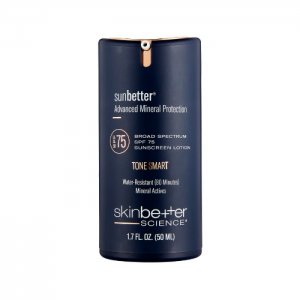We all love being outdoors in the summer, soaking up the sun, but while we’re spending that relaxing afternoon on the patio with friends, our skin is taking on massive amounts of ultraviolet (UV) radiation. Spending more time outdoors, especially during the sunny summer months, can lead to both short and long-term damage to the skin. In this blog, Dr. Amreen Sitabkhan of U.S. Dermatology Partners in Dallas and Carrollton, Texas will go through how the sun damages the skin, treatment options, and tips for prevention.
How Does Exposure to UVA & UVB Rays Damage Skin?
The UVA and UVB rays from the sun, tanning beds, and other light sources can damage skin both immediately and over time, leading to cumulative sun damage. According to Dr. Sitabkhan, “Some people know right away that their skin has been impacted by the sun when they burn or tan. Other people may not see signs right away. Instead, the damage is accumulated over time, and they develop dark spots or even skin cancers later in life. That’s why it’s so important to protect your skin from sun damage even if you aren’t someone who normally sunburns.”
Some of the many ways the UVA and UVB ray exposure can affect the skin include:
- Sunburns
- Suntans
- Freckles
- Moles
- Age spots/dark spots
- Fine lines and wrinkles
- Skin dehydration (dryness or leathery appearance)
- Weakened immune system and increased risk for infections and illness
- Skin cancers
How Much UVA & UVB Exposure Is Too Much?
Dr. Sitabkhan says, “Any exposure to UVA and UVB rays, including being out in the sun and using tanning beds, can damage your skin, but we also need sunlight to be healthy. Sunlight gives us vitamin D, which helps with calcium absorption and other important bodily processes. So, you don’t want to choose to avoid all sunlight, but you do need to make smart decisions and understand how to avoid the short and long-term negative effects of sun exposure. For example, I want to end the false belief about base tans. Having a tan or a sunburn already doesn’t mean your skin is magically free from the negative impact of additional exposure to the sun. This is absolutely not true; just the opposite, in fact. It’s important to minimize sun exposure and forgo the use of tanning beds altogether to maintain skin health and avoid the potentially serious repercussions of UV exposure.”
What Should I Do to Prevent Sun Damage?
According to Dr. Sitabkhan, “ You can’t, and shouldn’t, avoid all sun exposure. But, you should protect yourself, limit exposure, and play it smart. If you already have a sunburn, cover up or stay inside while you heal. If you have a tan, developing a deeper tan may look good now, but it increases your risk for potential skin health concerns like cancers and accelerated signs of aging down the road.”
Here are some tips to keep your skin healthy all year long:
- Wear sunscreen – You should wear sunscreen every day on any part of the body that is exposed to UVA/B rays. This is especially important if you’re going to be outdoors for prolonged periods. Wear a sunscreen with a sun protection factor (SPF) of 30 or greater that is labeled as broad-spectrum, which means it protects from UVA and UVB rays. Reapply at least every two hours.
- Take a break – Go indoors for a while, seek shade, wear a long-sleeved shirt. Whatever you can do to give your skin a break from the sun.
- Cover up – It’s warm in the summer, which means many people are wearing shorts, short-sleeved shirts, and bathing suits outdoors. Even if you don’t wear protective clothing all day, bring along pants and a long-sleeved shirt or cover up with a beach towel to give your skin a rest periodically. You should also wear hats, sunglasses, gloves, and other protective clothing items if you’re going to be outdoors for extended periods.
- Stay inside between 10 am and 4 pm – This one is pretty self-explanatory, but sun exposure is most likely to negatively affect skin during these peak hours.
- Perform self-exams – While examining your skin for signs of cancer and other skin health concerns can’t actually prevent sun damage, it can help minimize the impact of that damage on your skin and allow you to receive treatment in the earliest stages if something does go wrong.
Are There Dermatologic Treatments to Reverse Sun Damage?
Taking steps to avoid sun damage is always best, but if you are dealing with the effects of sun damage, your dermatologist can help you restore the appearance and health of your skin. According to Dr. Sitabkhan, “The fall and winter months are often ideal times to receive restorative treatments to address sun damage. Many of the recommended procedures require minimal or no sun exposure following treatment as the patient heals and the skin is sensitive, so now is the time to start scheduling your post-summer dermatology sessions.”
Some of the treatments your dermatologist may recommend include:
Laser Treatments
Laser therapy helps to promote cell turnover, remove damaged skin cells, and encourage the production of collagen and elastin. This means healthier skin with improved tone and texture. Depending on your specific situation, your dermatologist may recommend one of the following specific laser treatments:
- HALO laser skin resurfacing
- Fraxel laser skin resurfacing
- Laser Skin Resurfacing
- CO2 Laser Skin Resurfacing
- Erbium Laser Skin Resurfacing
- Spectra Laser Peel
- Clear + Brilliant Laser Treatment
Chemical Peels
One of the best ways to promote healing after sun damage is to remove the outer layers of damaged skin. Chemical peels dissolve the top layer of skin to expose healthy skin below. This causes faster shedding of dead skin cells, which is also beneficial for people who struggle with acne. The new skin revealed after chemical peels typically has a smoother skin tone and texture.
Microneedling
Microneedling, also called collagen induction therapy, is a procedure that utilizes very small-gauge needles to create micro-injuries. These small perforations in the skin’s surface cause the body to kick into healing mode, which means faster cell turnover and increased production of proteins like collagen and elastin that give our skin a supple, youthful appearance. Microneedling can address numerous adverse effects of sun damage, including fine lines, wrinkles, and dark spots.
Schedule an Annual Exam with a Knowledgeable Dermatologist
One of the best ways to keep your skin looking and feeling healthy and youthful is to visit a dermatologist at least once a year for an annual exam. During these visits, your dermatologist will examine you for signs of sun damage as well as other skin health concerns in order to recommend early, conservative interventions. If you’re interested in visiting with us at U.S. Dermatology Partners, you just need to take a few minutes to fill out our online request form. One of our team members in your area will be in touch to finalize the details.
Find a location near me
or



